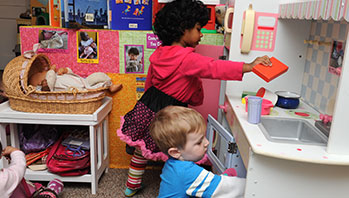- baskets
- books about flowers
- cans,
- class color chart
- containers
- markers
- paper
- pencils
- tape
- tissue paper flowers or other pretend flowers
- toy cash register
- toy telephone
- bouquet
- color word
- customer
- florist
- flower
- gift card
- message
- order
- vase
MA Standards:
English Language Arts/Speaking and Listening/SL.PK.MA.1 Participate in collaborative conversations with diverse partners during daily routines and play.
Head Start Outcomes:
Approaches to Learning/Initiative and Curiosity Demonstrates flexibility, imagination, and inventiveness in approaching tasks and activities.
Logic and Reasoning/Symbolic Representation Engages in pretend play and acts out roles.
PreK Learning Guidelines:
English Language Arts/Language 4 Engage in play experiences that involve naming and sorting common words into various classifications using general and specific language.
English Language Arts/Composition 18 Use emergent writing skills to make letters in many settings and for many purposes.
Flower Shop

© Commonwealth of Massachusetts, Department of Early Education and Care (Jennifer Waddell photographer). All rights reserved.
Skill Focus: Color Identification, Environmental Print, Imaginative Play, Listening and Speaking, Vocabulary
Help children create a flower or garden shop. Explain that people often buy flowers to give as presents, like the girl in Flower Garden. Sometimes people come into the flower shop and pick out their flowers. The florist—the person who works in the flower shop—helps arrange the flowers in a nice bouquet. Sometimes people call the florist on the telephone and tell the florist what kind of flowers they want and where they want to send them.
Together, decide on a name for the flower shop and help children create a sign. Have children help you put the flowers in cans or containers and sort them by different categories, such as long stem/short stem, red flowers with little leaves/red flowers with big leaves, flowers with many leaves/flowers with few leaves, etc. Children can make signs for each type of flower. Encourage children to play the roles of a florist and a customer. The florist can arrange flowers, answer the phone, write flower orders, and write messages for gift cards. Model these activities and a dialogue between a customer and a florist.
- Customer: It’s my mother’s birthday today. Red is her favorite color. Do you have any red flowers?
- Florist: Yes, we have some beautiful red roses over here. How many would you like?
Adaptation: For groups with children who understand the concept of using money, have some plastic coins available for customers to buy the flowers. You may want to have children make price signs for the flowers (1–10¢).
Adaptation: For groups with various age ranges you may wish to pair older and younger children so that older children can “guide” younger ones in how to make up dialogue.
